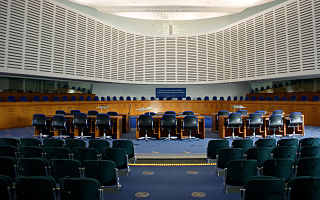Related Research Articles

The European Convention on Human Rights is an international convention to protect human rights and political freedoms in Europe. Drafted in 1950 by the newly formed Council of Europe, the convention entered into force on 3 September 1953. All Council of Europe member states are party to the convention and new members are expected to ratify the convention at the earliest opportunity.

The Human Rights Act 1998 is an Act of Parliament of the United Kingdom which received royal assent on 9 November 1998, and came into force on 2 October 2000. Its aim was to incorporate into UK law the rights contained in the European Convention on Human Rights. The Act makes a remedy for breach of a Convention right available in UK courts, without the need to go to the European Court of Human Rights (ECHR) in Strasbourg.
Human rights in the United Kingdom concern the fundamental rights in law of every person in the United Kingdom. An integral part of the UK constitution, human rights derive from common law, from statutes such as Magna Carta, the Bill of Rights 1689 and the Human Rights Act 1998, from membership of the Council of Europe, and from international law.

Pearse Jordan was a Provisional Irish Republican Army (IRA) volunteer killed by a Royal Ulster Constabulary officer. In 2001 the European Court of Human Rights ordered the British Government to pay fines to the families of several IRA men, including Jordan's, after holding that the men's human rights were violated by flawed inquest procedures. Following this judgement, British law regarding inquests was changed.
Redfearn v United Kingdom [2012] ECHR 1878 is a UK labour law and European Court of Human Rights case. It held that UK law was deficient in not allowing a potential claim based on discrimination for one's political belief. Before the case was decided, the Equality Act 2010 provided a remedy to protect political beliefs, though it had not come into effect when this case was brought.
Article 8 of the European Convention on Human Rights provides a right to respect for one's "private and family life, his home and his correspondence", subject to certain restrictions that are "in accordance with law" and "necessary in a democratic society". The European Convention on Human Rights (ECHR) is an international treaty to protect human rights and fundamental freedoms in Europe.
In the European Convention on Human Rights, Article 2 protects the right to life. The article contains a limited exception for the cases of lawful executions and sets out strictly controlled circumstances in which the deprivation of life may be justified. The exemption for the case of lawful executions has been subsequently further restricted by Protocols 6 and 13, for those parties who are also parties to those protocols.
Article 3 of the European Convention on Human Rights prohibits torture, and "inhuman or degrading treatment or punishment".
Article 3 – Prohibition of torture
No one shall be subjected to torture or to inhuman or degrading treatment or punishment.
S and Marper v United Kingdom [2008] ECHR 1581 is a case decided by the European Court of Human Rights which held that holding DNA samples of individuals arrested but who are later acquitted or have the charges against them dropped is a violation of the right to privacy under the European Convention on Human Rights.
Mosley v United Kingdom [2011] 53 E.H.R.R. 30 was a 2011 decision in the European Court of Human Rights regarding the right to privacy under Article 8 of the European Convention on Human Rights. An application to the court was made by Max Mosley, the former president of the FIA, after his successful breach of confidence legal case against the News of the World. In that case, the court unanimously rejected the proposition that Article 8 required member states of the Council of Europe to legislate to prevent newspapers printing stories regarding individual private lives without first warning the individuals concerned. It instead held that it fell within each state's margin of appreciation to determine whether to legislate on that matter.
Podkolzina v. Latvia (46726/99) was a case argued before the European Court of Human Rights and decided in 2002.
Smith and Grady v UK (1999) 29 EHRR 493 was a notable decision of the European Court of Human Rights that unanimously found that the investigation into and subsequent discharge of personnel from HM Forces on the basis they were homosexual was a breach of their right to a private life under Article 8 of the European Convention on Human Rights. The decision, which caused widespread controversy at the time led the UK to adopt a revised sexual-orientation-free Armed Forces Code of Social Conduct in January 2000. In UK law the decision is notable because the applicants' case had previously been dismissed in both the High Court and Court of Appeal, who had found that the authorities' actions had not violated the principles of legality including Wednesbury unreasonableness, thus highlighting the difference in approach of the European Court of Human Rights and the domestic courts.
Article 12 of the European Convention on Human Rights (ECHR) provides for two constituent rights: the right to marry and the right to found a family. With an explicit reference to ‘national laws governing the exercise of this right’, Article 12 raises issues as to the doctrine of the margin of appreciation, and the related principle of subsidiarity most prominent in European Union Law. It has most prominently been utilised, often alongside Article 8 of the Convention, to challenge the denial of same sex marriage in the domestic law of a Contracting state.

Cadder v HM Advocate [2010] UKSC 43 is a decision in which the Supreme Court of the United Kingdom held that the way in which police in Scotland detained suspects was not compatible with the European Convention on Human Rights and was therefore unlawful in terms of the Scotland Act 1998.
Article 18 of the European Convention on Human Rights (ECHR) states:
The restrictions permitted under this Convention to the said rights and freedoms shall not be applied for any purpose other than those for which they have been prescribed.
Christine Goodwin v. United Kingdom is a case decided by the European Court of Human Rights on 11 July 2002. The applicant, Christine Goodwin, a United Kingdom national born in 1937, was a transgender woman. She claimed that she had problems and faced sexual harassment at work during and following her gender-affirming surgery. She also alleged that the fact that she kept the same National Insurance number meant that her employer had been able to discover that she previously worked for them under another name and sex, with resulting in embarrassment and humiliation.
Eiseman-Renyard and others v the United Kingdom is a 2019 European Court of Human Rights case between Hannah Eiseman-Renyard and seven other applicants against the United Kingdom for an alleged breach of Article 5 of the European Convention on Human Rights. The case revolved around the Metropolitan Police arresting the claimants prior to the wedding of Prince William and Catherine Middleton based on intelligence that the group intended to disrupt the wedding. The claimants argued that they had been arrested on no valid preventive basis. The Court dismissed the claim as inadmissible due to ill-founded beliefs.

Carson and Others v The United Kingdom [2008] ECHR 1194 was heard by the European Court of Human Rights (ECHR), Fourth Section in Strasbourg on 4 November 2008 appeal from the Appellate Committee of the House of Lords before Lech Garlicki (President); Nicolas Bratza; Giovanni Bonello; Ljiljana Mijović; David Thór Björgvinsson; Ledi Bianku; Mihai Poalelungi.

Robinson v Chief Constable of West Yorkshire Police[2018] UKSC 4 is a leading English tort law case on the test for finding a duty of care. An elderly woman was injured by two police officers attempting to arrest a suspect and she claimed that the police owed her a duty of care not to be put in danger. The UK Supreme Court found that the police did owe a duty of care in this case as there was no general rule that the police are not under any duty of care when performing their duties.
References
- CA Gearty, 'Unravelling Osman' (2001) 64(2) Modern Law Review 159